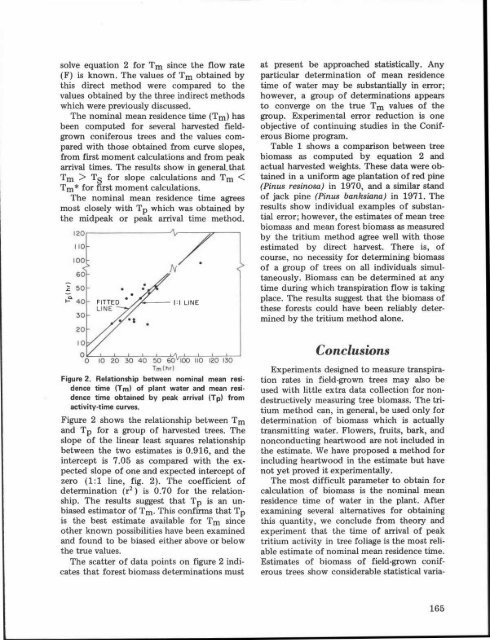PE EIE[R-Rg RESEARCH ON - HJ Andrews Experimental Forest
PE EIE[R-Rg RESEARCH ON - HJ Andrews Experimental Forest
PE EIE[R-Rg RESEARCH ON - HJ Andrews Experimental Forest
Create successful ePaper yourself
Turn your PDF publications into a flip-book with our unique Google optimized e-Paper software.
solve equation 2 for Tm since the flow rat e<br />
(F) is known . The values of Tm obtained b y<br />
this direct method were compared to th e<br />
values obtained by the three indirect method s<br />
which were previously discussed .<br />
The nominal mean residence time (Tm) ha s<br />
been computed for several harvested field -<br />
grown coniferous trees and the values compared<br />
with those obtained from curve slopes ,<br />
from first moment calculations and from peak<br />
arrival times . The results show in general, that<br />
Tm > TS for slope calculations and Tm <<br />
Tm * for first moment calculations .<br />
The nominal mean residence time agree s<br />
most closely with Tp which was obtained b y<br />
the midpeak or peak arrival time method .<br />
2 0<br />
I 0<br />
o ► 1 I I_ I 1<br />
0 10 20 30 40 50 6000 110 120 13 0<br />
Tm(hr )<br />
Figure 2 . Relationship between nominal mean residence<br />
time (Tm) of plant water and mean residence<br />
time obtained by peak arrival (Tp) fro m<br />
activity-time curves .<br />
Figure 2 shows the relationship between T m<br />
and Tp for a group of harvested trees . Th e<br />
slope of the linear least squares relationshi p<br />
between the two estimates is 0 .916, and the<br />
intercept is 7 .05 as compared with the expected<br />
slope of one and expected intercept of<br />
zero (1 :1 line, fig. 2). The coefficient o f<br />
determination (r2 ) is 0.70 for the relationship.<br />
The results suggest that Tp is an unbiased<br />
estimator of Tm . This confirms that Tp<br />
is the best estimate available for Tm since<br />
other known possibilities have been examined<br />
and found to be biased either above or belo w<br />
the true values .<br />
The scatter of data points on figure 2 indicates<br />
that forest biomass determinations must<br />
C<br />
at present be approached statistically . Any<br />
particular determination of mean residenc e<br />
time of water may be substantially in error ;<br />
however, a group of determinations appear s<br />
to converge on the true Tm values of th e<br />
group. <strong>Experimental</strong> error reduction is on e<br />
objective of continuing studies in the Coniferous<br />
Biome program .<br />
Table 1 shows a comparison between tre e<br />
biomass as computed by equation 2 an d<br />
actual harvested weights. These data were obtained<br />
in a uniform age plantation of red pin e<br />
(Pinus resinosa) in 1970, and a similar stan d<br />
of jack pine (Pinus banksiana) in 1971. Th e<br />
results show individual examples of substantial<br />
error; however, the estimates of mean tre e<br />
biomass and mean forest biomass as measured<br />
by the tritium method agree well with thos e<br />
estimated by direct harvest . There is, of<br />
course, no necessity for determining biomas s<br />
of a group of trees on all individuals simultaneously<br />
. Biomass can be determined at an y<br />
time during which transpiration flow is takin g<br />
place. The results suggest that the biomass of<br />
these forests could have been reliably determined<br />
by the tritium method alone .<br />
Conclusions<br />
Experiments designed to measure transpiration<br />
rates in field-grown trees may also b e<br />
used with little extra data collection for non -<br />
destructively measuring tree biomass . The tritium<br />
method can, in general, be used only for<br />
determination of biomass which is actually<br />
transmitting water . Flowers, fruits, bark, and<br />
nonconducting heartwood are not included i n<br />
the estimate. We have proposed a method for<br />
including heartwood in the estimate but have<br />
not yet proved it experimentally .<br />
The most difficult parameter to obtain for<br />
calculation of biomass is the nominal mea n<br />
residence time of water in the plant . After<br />
examining several alternatives for obtainin g<br />
this quantity, we conclude from theory and<br />
experiment that the time of arrival of pea k<br />
tritium activity in tree foliage is the most reliable<br />
estimate of nominal mean residence time .<br />
Estimates of biomass of field-grown coniferous<br />
trees show considerable statistical varia -<br />
165








